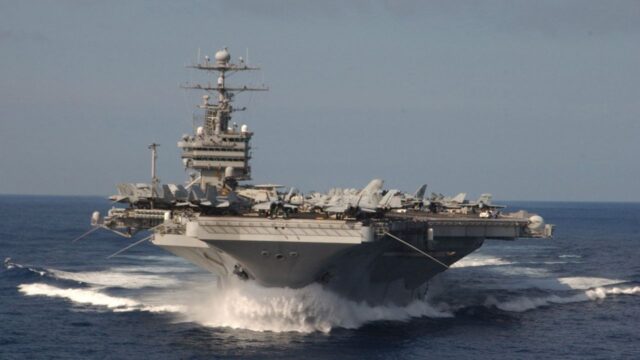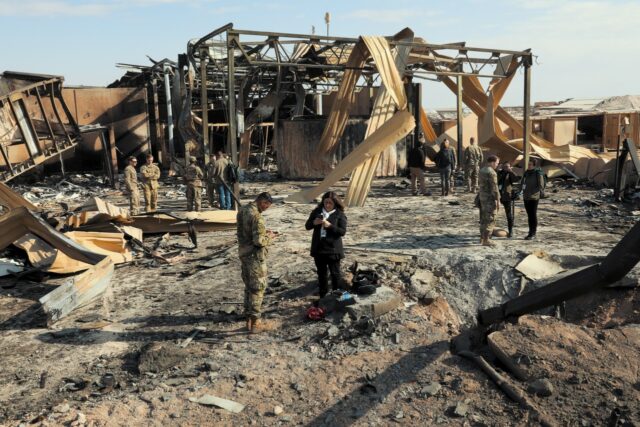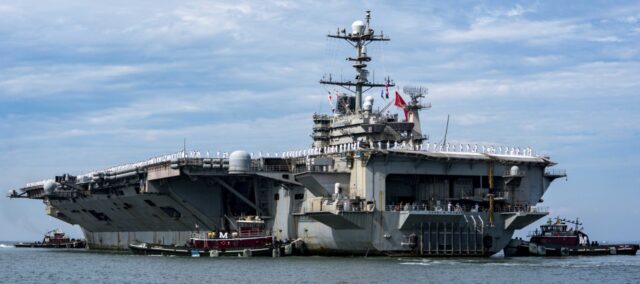Aircraft carriers are a manifestation of American superpower, their task is to ensure the ability to project power in various regions of the world. But is it profitable for the United States to maintain a ship of this class in order to deter Iran? President Joe Biden’s administration has indicated from the outset that it is not the Islamic Republic that is the greatest threat to US security. The threat lies in the Indo-Pacific region and the growing role of the People’s Republic of China’s navy, which is painstakingly building its aircraft carrier fleet.
This is also the opinion of Lieutenant Commander Stephen Walsh, who wrote his comments in the article Stop Sending Carriers to CentCom. The Chinese fleet development program led to the problem of the proper (read: effective) deployment of American aircraft carriers, which has been analyzed for a long time. As early as August 2021, The Washington Institute for Near East Policy, an American think tank researching US foreign policy in the Middle East, doubted whether deterring Iran would translate into long-term benefits.
Since the 1991 Gulf War, the US Navy has generally held at least one of the ten aircraft carriers on operational readiness in the Persian Gulf region (with a strike group that also includes a cruiser and three or four destroyers) and one amphibious assault ship.
-ADVERTISEMENT-

Has Iran ever feared aircraft carriers?
Or to put it another way: are American ships scaring Iran away and keeping its hands tied in the waters of the Persian Gulf? Absolutely not. In August 2021, Michael Eisenstadt and Henry Mihm published the article Do Aircraft Carriers Deter Iran ?, in which they emphasized that since 1991, aircraft carriers have never responded with fire to attacks on American interests organized by Iran or pro-Iranian Shiite militias. At various times, the US Central Command (CENTCOM) generally had either one or two aircraft carriers at its disposal.

USS John C. Stennis going to the Persian Gulf, 2012.
(Randi R. Brown, US Navy)
Despite this strength, aircraft carriers remained silent after the 1996 bombing (attributed to Lebanese Hezbollah and Iran) on a building inhabited by American military families in Az-Zahran, Saudi Arabia. They have not been used after numerous attacks by pro-Iranian militias that killed more than 600 Americans in Iraq after 2003, and dozens of rocket attacks on the US embassy and US military personnel in Iraq since 2019.
Washington did not retaliate when Iran’s Ra’ad air defense system downed the RQ-4A drone in June 2020. Moreover, when in January 2020 – after the assassination of Ghasem Soleimani – Iranian missiles fell on Iraqi Ain Al-Assad airbases in the western part of Anbar province and in Erbil in Iraqi Kurdistan, the carrier was not used for any operation against Iran.

Ain al-Assad base on January 12, 2020.
(US Army / Spc. Derek Mustard)
The aircraft carrier strike group had just one success. In April 2015, an Iranian naval convoy that was trying to deliver weapons to the Houthis fighters in Yemen turned back as American ships headed by USS Theodore Roosevelt approached it. Routine daily flights by combat aircraft near the convoy forced Iranian officers to change course, but did not discourage Iran from delivering weapons to the Ansar Allah group. It should be noted, however, that a naval blockade, including forcing the enemy to give up the carriage of contraband (or to combine over other methods), can be implemented without the participation of an aircraft carrier. This is evidenced by the presence of a multinational naval force established in September 2019 to ensure freedom of navigation in the Persian Gulf.
One of the greatest tangible threats to stability in the region today seems to be the smuggling of weapons for Houthi fighters. The restrictions introduced by UN Security Council Resolution 2216 did not deter Iran from handing over light weapons, anti-tank grenade launchers, ballistic missiles and circulating ammunition to the rebels. In July, a joint US-UK team achieved significant success in tackling illegal contraband. At the same time, the US Navy’s 5th Fleet has decided to offer information rewards that can assist in the interception of weapons, drugs and other illegal shipments across the region.
The above means that in times of relative peace with Iran at sea, much simpler means can be dealt with, especially since the Iranian Navy is not ready for a great naval battle with a much stronger enemy. Tehran is clearly expanding its surface and submarine fleet, but only to carry out harassment and guerrilla warfare. Examples include the last two theft (or attempted) incidents of US Saildrone Explorer UAVs.
For these operations, the Iranians used the auxiliary ship Shahid Bazjar in the first case, and in the second – the Jamaran frigate of the Mujah type, i.e. not very technically advanced units. In practice, it was a variation on the actions of Pasdaran’s high-speed motorboats harassing US vessels, such as the USS Firebolt patrol vessel in April 2021 or the USS Georgia submarine escort next month. The Iranians are doing nothing about the presence of a U.S. airship in the region except for bullying over the Nimitz mock-up during the July 2020 exercises.
New imagery from yesterday shows the capsized #IRGC replica of the Nimitz Class Carrier appears to have listed more outside of Bandar Abbas Port, #Iran. She appears more listed here than previous imagery from the 31st July. The depth here is a reported 14m. Fun to reclaim…. pic.twitter.com/tKTHJAaGCS
– Aurora Intel (@AuroraIntel) August 2, 2020
An aircraft carrier (or two) will be needed if there is an armed conflict with the Ayatollahs at stake – rather in the form of aid given to Israel. An operation against Iranian nuclear installations, as a last resort, would require planning and the possible deployment of an aircraft in this area. If it will be needed there at all, because Israel is making plans for an independent attack, and requires the ally to provide technical assistance, which is to be the KC-46A Pegasus flying tanks.
Therefore, the advisability of keeping the carrier within the CENTCOM properties is questionable. Israel and other countries are helping to fulfill the task of keeping Iran from spreading its wings. However, it should not be forgotten that the presence of an aircraft carrier in a given region is not only an expression of the desire to have greater control over military and political affairs, but also a sign of prestige. On the other hand, keeping ships of this class in regions where they are not essential adversely affects their availability elsewhere, increases costs and reduces repair and maintenance time, or lengthens the time spent at sea by seafarers, which does not necessarily have a positive impact on their family life. With the advent of the Biden era, the American political scene is considering whether the president will resign from sending an aircraft carrier to the Middle East.
China, Europe or Iran?
Department of Defense decisions deprive the Indo-Pacific Command (IndoPaCom) and the European Command of the aircraft necessary for strategic competition. There are increasing demands to stop favoring CENTCOM. Some symptoms of the trend change could be noticed at the end of December 2021, when Washington decided not to send USS Harry S. Truman to the Persian Gulf region. Together with the aviation component and the escort ships – together forming the Carrier Strike Group 8 – it remained in the Mediterranean Sea.
US Defense Secretary Lloyd Austin had already stated then that this step was justified by the tense situation on the Russian-Ukrainian border. Truman was supposed to provide a projection of power in the event of a threat from Russia to attack any member of the North Atlantic Alliance. In March, it was decided that Truman would stay there longer. In mid-August, its presence in the Mediterranean basin ended, but due to the still dangerous situation in Eastern Europe, Truman was relieved by USS George HW Bush (CVN 77) together with the CSG 10 strike group.

Truman being driven by tugs at the Norfolk base.
(US Navy / Mass Communication Specialist 2nd Class Nathan T. Beard)
The increase in the potential of the People’s Republic of China, and in particular its navy, is prompting Washington to reflect on the proper management of maritime forces. In June, the Fujiana, the third Chinese carrier and the first nearly as large as the US Gerald R. Ford aircraft, was launched. It joined Shandong and Liaoning, but Beijing identifies Fujiana as the first full-fledged carrier and declares that it would like to have six ships of this class together. It remains a mystery whether Liaoning – currently treated as an experimental unit in the development of Chinese aircraft carriers – will be included in the total.
CENTCOM’s focus on Iran is not entirely consistent with Donald Trump’s 2018 National Defense Strategy, which established the 4 + 1 rule. According to it, Iran was classified as the fourth greatest threat to the United States after China, Russia and North Korea. A separate category are non-state terrorist groups. Strategic guidelines are one thing, factual decisions are another. At a time when Trump was in the Oval Office, the list was turned upside down by the so-called “maximum pressure campaign.” According to it, Iran was the greatest threat, replacing strategic goals – rivalry with China and Russia.
The Biden administration has moved away from a policy of force towards Iran. In March 2021, the president signed the “Temporary Strategic National Security Guidelines”, which moved away from the tactic of “maximum pressure”. The US position has become more conciliatory, shifting Washington onto a more diplomatic course seen with former White House Democrat Barack Obama. Therefore, there are more and more arguments that the continued presence of the American aircraft carrier in the Middle East was only the result of CENTCOM’s lobbying in the Pentagon, and not a result of the real needs of the US Navy.
See also: New version of JLTV with more firepower
Petty Officer 2nd Class James Evans

